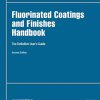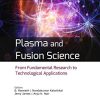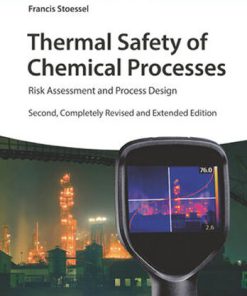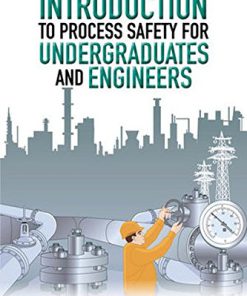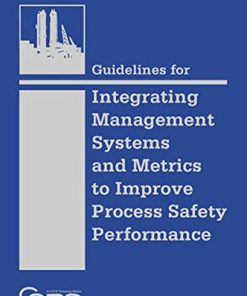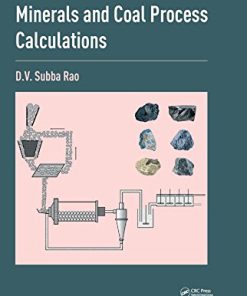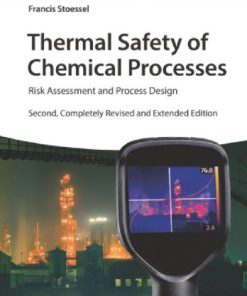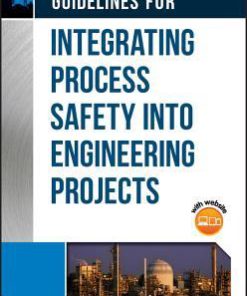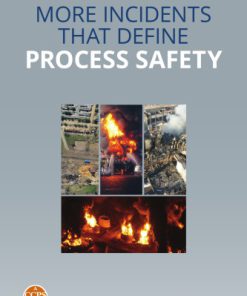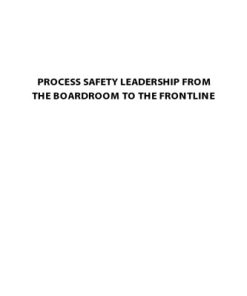Process Safety Calculations 2nd Edition by Renato Benintendi ISBN 0128235160 9780128235164
$50.00 Original price was: $50.00.$25.00Current price is: $25.00.
Process Safety Calculations 2nd Edition by Renato Benintendi – Ebook PDF Instant Download/Delivery: 0128235160, 978-0128235164
Full download Process Safety Calculations 2nd Edition after payment
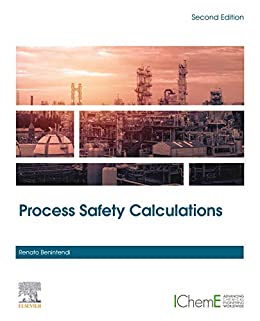
Product details:
ISBN 10: 0128235160
ISBN 13: 978-0128235164
Author: Renato Benintendi
Process Safety Calculations, Second Edition remains to be an essential guide for students and practitioners in process safety engineering who are working on calculating and predicting risks and consequences. The book focuses on calculation procedures based on basic chemistry, thermodynamics, fluid dynamics, conservation equations, kinetics and practical models. It provides helpful calculations to demonstrate compliance with regulations and standards, such as Seveso directive(s)/COMAH, CLP regulation, ATEX directives, PED directives, REACH regulation, OSHA/NIOSH and UK ALARP, along with risk and consequence assessment, stoichiometry, thermodynamics, stress analysis and fluid-dynamics.
This fully revised, updated and expanded second edition follows the same organization as the first, including the original three main parts, Fundamentals, Consequence Assessment and Quantitative Risk Assessment. However, the latter part is significantly expanded, including an appendix consisting of five fundamental thematic areas belonging to the risk assessment framework, including in-depth calculations methodologies for some fundamental monothematic macro-areas of process safety.
- Revised, updated and expanded new edition that includes newly developing areas of process safety that are relevant to QRA
- Provides engineering fundamentals to enable readers to properly approach the subject of process safety
- Includes a remarkable and broad numbers of calculation examples, which are completely resolved and fully explained
- Develops the QRA subject, consistently with the methodology applied in the big projects
Process Safety Calculations 2nd Table of contents:
Part 1: Fundamentals
Chapter 1: Chemistry of Process Safety
- Abstract
- 1.1: Stoichiometry and Mass Balances
- 1.2: States of Substances in Process Safety
- 1.3: Mass and Concentration Units in Process Safety
- 1.4: Solutions and Chemical Equilibrium
- 1.5: Absorption and Adsorption
- 1.6: Applications
Chapter 2: Thermodynamics and Thermochemistry of Process Safety
- Abstract
- 2.1: Ideal Gases
- 2.2: Real Gases
- 2.3: Polytropic Transformations
- 2.4: State Functions
- 2.5: Thermodynamic Properties
- 2.6: Heat Transfer Mechanisms
- 2.7: Applications
Chapter 3: Reaction Engineering of Process Safety
- Abstract
- 3.1: Background
- 3.2: Reactive Hazards
- 3.3: Homogeneous Reactions
- 3.4: Heterogeneous Reactions
- 3.5: Reactor Schemes
- 3.6: Combustion Reactions
- 3.7: Reaction Heat
- 3.8: Combustion Heat
- 3.9: Heat of Solution
- 3.10: Heat of Neutralisation
- 3.11: Endothermic Processes
- 3.12: Pyrophoricity
- 3.13: Reactivity of Remarkable Substances
- 3.14: Self-Heating
- 3.15: Water and Spray Curtains
Chapter 4: Fluid Dynamics of Process Safety
- Abstract
- 4.1: Equations of Conservation
- 4.2: Joule–Thomson Expansion in Process Safety
- 4.3: Turbulent and Laminar Flows
- 4.4: Liquid Elasticity (Bulk Modulus)
- 4.5: Fluid Hammer (Surge)
- 4.6: Theory of Jets
- 4.7: Buoyancy
- 4.8: Flashing Liquids
- 4.9: Spray Release and Droplet Dynamics
- 4.10: Pool Evaporation
- 4.11: Hydrogen Sulphide Release From Free Surfaces
Chapter 5: Loads and Stress Analysis of Process Safety
- Abstract
- 5.1: Structural Failure Scenarios in Process Safety
- 5.2: Key Concepts
- 5.3: Stresses
- 5.4: Membrane Stresses in Thin-Shell Structures
- 5.5: Forces in Piping Bends
- 5.6: Thermal Loads
- 5.7: Flixborough UVCE: Analysis of the Structural Causes
Chapter 6: Statistics and Reliability of Process Safety
- Abstract
- 6.1: Background
- 6.2: Probit Functions for Process Safety
- 6.3: Failure Frequency and Probability
- 6.4: Failures and Faults
- 6.5: Boolean Algebra
- 6.6: Boolean Algebra in Functional Safety
Part 2: Consequence Assessment
Chapter 7: Source Models
- Abstract
- 7.1: Summary of Scenarios
- 7.2: Subcooled Liquids
- 7.3: Boiling Liquids
- 7.4: Rainout and Flashing—Liquid Droplets Formation
- 7.5: Carbon Dioxide: Liquid-to-Solid Transition
- 7.6: Gases and Vapours
- 7.7: Pool Formation and Liquid Evaporation
- 7.8: US EPA Offsite Consequence Analysis (OCA) Models
- 7.9: Simplified Formulas
Chapter 8: Dispersion Models
- Abstract
- 8.1: Summary of Scenarios
- 8.2: Dispersion Key Drivers
- 8.3: Meteorology
- 8.4: Buoyancy
- 8.5: Momentum-Dominated Jet Behaviour
- 8.6: Density and Thermal Positively Buoyant Plumes
- 8.7: Thermal Plume Rise
- 8.8: Negatively Buoyant Plumes (Dense Gas)
- 8.9: Transition to Passive Dispersion
- 8.10: Gaussian Dispersion
Chapter 9: Fire
- Abstract
- 9.1: Summary of Scenarios
- 9.2: Ignition Sources
- 9.3: Pyrophoric Materials
- 9.4: Relevance and Effects of Ignition Sources
- 9.5: Analysis of Ignition Sources
- 9.6: Ignition Probability
- 9.7: Fire Scenarios
- 9.8: Fire Damage to People
Chapter 10: Explosions
- Abstract
- 10.1: Summary of Scenarios
- 10.2: The Explosion
- 10.3: Laminar Burning Velocity
- 10.4: Flame Speed and Turbulent Velocity
- 10.5: Explosion With Oxidisers Other Than Oxygen
- 10.6: Confined Explosion: Deflagration and Detonation
- 10.7: Detonation in Pipes
- 10.8: Reflected Shock Wave and Pressure Temporal–Spatial Distribution
- 10.9: Semiconfined Explosion
- 10.10: Unconfined Vapour Cloud Explosion
- 10.11: Vessels Burst
- 10.12: Boiling Liquid Expansion Vapour Explosion
- 10.13: Rapid Phase Transition (RPT)
- 10.14: Thermal Runaway
- 10.15: Design and Operational Issues: Hot Spots
- 10.16: Pressure Piling
- 10.17: Drag Loads
- 10.18: Loads on Buildings
- 10.19: Blast-Resistant Structures in the QRA Framework
- 10.20: Hazardous Area Classification
- 10.21: Inerting
Chapter 11: Dust Explosions
- Abstract
- 11.1: Powders Classification
- 11.2: Dust Explosions Thermodynamics
- 11.3: Explosion Inherent Hazard
- 11.4: Dusts Explosivity Data
- 11.5: Venting Devices
- 11.6: Equipment Plants for Dust Processing
- 11.7: HAZID of Equipment and Process Scenarios
- 11.8: Quantified Risk Assessment
- 11.9: Risk Assessment in the ATEX Framework
- 11.10: Analysis of an Incident: Imperial Sugar Company Explosion
Part 3: Quantitative Risk Assessment
Chapter 12: Quantitative Risk Assessment
- Abstract
- 12.1: Definitions
- 12.2: ALARP Model
- 12.3: PLL from the FN Curve
- 12.4: ALARP Demonstration—ICAF Method
- 12.5: Parts Count
Chapter 13: Structural Dynamics of Buildings Subject to Blast Loads
- Abstract
- 13.1: Shock and Pressure Waves
- 13.2: Box-Like Structure Model
- 13.3: Blast Loads
- 13.4: Blast Parameters
- 13.5: Design Criteria for Blast-Affected Building
- 13.6: Dynamic Blast Analysis of Buildings
- 13.7: The Blast Design
Chapter 14: Layer of Protection Analysis
- Abstract
- 14.1: Definitions
- 14.2: Layer of Protection Analysis (LOPA)
- 14.3: Initiating Events
- 14.4: Independent Protection Layers (IPLs)
- 14.5: Conditional Modifiers (CMs)
- 14.6: Procedure of LOPA Execution for SIL Assignment
Chapter 15: Explosion Protection of Vessels and Enclosures
- Abstract
- 15.1: Scope
- 15.2: Definitions
- 15.3: Rules of Thumb
- 15.4: Stress Analysis of Vessels and Related Structural Elements
- 15.5: Establishment of Reduced Pressure Pred
- 15.6: Venting of Gas Explosions in Isolated Compact Enclosures
- 15.7: Venting of Dust Explosions in Isolated Compact Enclosures
- 15.8: Actions on Supporting Structures of Vessels
- 15.9: Vent Ducts
Chapter 16: Mitigation of Toxic Risk
- Abstract
- 16.1: Scope
- 16.2: Definitions
- 16.3: The Toxic Roadmap
- 16.4: Acute Toxicity of Substances and Mixtures
- 16.5: Toxicity Indices
- 16.6: Calculations for Mixtures of Toxic Chemicals
- 16.7: Quantitative Methods for Offsite Consequence Management
- 16.8: Techniques of Toxic Risk Mitigation
Chapter 17: Integrity Management of Equipment Subject to Fires
- Abstract
- 17.1: Scope
- 17.2: Fire on Equipment and Structures
- 17.3: Criteria for Depressurisation
People also search for Process Safety Calculations 2nd:
process safety calculations renato benintendi pdf
what is process safety
process safety incident severity rate
define process safety
osha process safety management quizlet
Tags:
Renato Benintendi,Process,Safety,Calculations 2nd
You may also like…
Chemistry
Thermal Safety of Chemical Processes Risk Assessment and Process Design 2nd Edition Francis Stoessel
Business & Economics - Mathematical Economics
Science (General)
Thermal Safety of Chemical Processes Risk Assessment and Process Design 2nd Edition Francis Stoessel
Arts - Music
The Horn 1st Edition by Renato Meucci, Gabriele Rocchetti ISBN 0300118937 9780300118933
Engineering - Engineering - General & Miscellaneous


